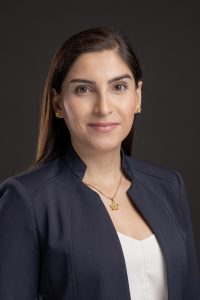
Aida is a 4th-year radiology resident at the University of Toronto. She has been a member of the CAIR Residents and Fellows Section for the past three years, where she currently acts as the Vice Chair. She shares her perspectives as a resident pursuing interventional radiology.
What initially sparked your interest in interventional radiology, and how did your experiences during residency influence your decision to specialize in this field?
In medical school I was drawn to procedural specialties which led me to organize an interventional radiology elective. I was instantly captivated by the dynamic and innovative field of IR. IR seemed to embody the forefront of medicine—cutting-edge, rapidly evolving, and integral to patient care. Upon starting radiology residency, I arranged multiple IR rotations early on in my training to gain more exposure to the field. Despite the long days and the complex nature of the speciality with its steep learning curve, IR was consistently the rotation where I felt most engaged and fulfilled.
Looking for ways to explore this field, I became involved in research projects which opened doors for presenting at conferences and meeting interventionalists from Canada, United States and Europe. These experiences broadened my understanding of the diverse scope of IR. Furthermore, I met role models, including other female IRs, who were leading successful and fulfilling careers. Their mentorship and willingness to discuss the field with me were invaluable. Additionally, my involvement with CAIR has been a key part of my journey. The organization provided me with numerous opportunities to engage in IR-related projects particularly within the Residents and Fellows section, where I now have the privilege of acting as vice chair
What advice would you give to women as medical students or residents who are still exploring different specialties but are curious about interventional radiology?
Consider exploring IR as a specialty early on in your training. Explore the field by organizing IR electives and rotations. Work with various staff, and at different sites in order to explore the breadth and depth of a career in IR.
Become involved in the IR community. Join the CAIR organization, which gives you access to several in-person and virtual events where you can learn more about the field, network with IR fellows and staff, and attend the CAIR annual conference.
Lastly, pave your own path. Don’t be limited by what others perceive is a good career fit for you. Don’t let naysayers discourage you from pursuing your passion. Afterall, there are successful female surgeons across all surgical specialties, and IR is not any different.
Can you share any advice on how to build a professional network during residency, particularly within the field of interventional radiology?
Attend IR conferences and meetings, where you can network with people across the country and beyond. For me, I did not see a lot of women in IR at my current institution, however when I attended national and international conferences, I saw that there were many women in IR, with fulfilling and successful careers, who were spearheading trials, leading departments, and performing cutting edge procedures; these became the people whom I looked up to.
Share with others you are interested in IR. This opens up opportunities as they will connect you to mentors and put your name forward when opportunities come up. Reach out to residents and fellows pursuing IR for career exploration, who can provide guidance and be a great resource.
Are there any specific resident-focused organizations, workshops, or conferences that you found particularly beneficial for career development in interventional radiology?
The CAIR Residents and Fellows section hold several events throughout the year, including Virtual Angio Club, introduction to IR events for medical students, women in IR panel discussions, just to name a few! The CAIR annual meeting along with its Trainee Day is also another excellent opportunity to network and learn about IR.
The Society of Interventional Radiology (SIR) and the Cardiovascular and Interventional Radiology Society of Europe (CIRSE) conferences are also great events to attend and learn about IR at a global stage. Both societies also offer a myriad of virtual meetings which are valuable avenues for career exploration.
What role do mentorship and peer support play in your residency experience, and how have you sought out these resources?
I was fortunate to have many incredible mentors who took the time to teach me procedures, even on their busiest days, encouraged me to attend conferences, supported my research projects, and genuinely invested in helping me pursue this specialty. Senior residents and fellows also played a crucial role by offering valuable insights on how to navigate the process of preparing for and applying to the field. As you consider a career in interventional radiology, you may encounter well-intentioned individuals who voice doubts or reinforce stereotypical views of the field, such as: IR is not well-suited for women, that it doesn’t align with family life, or that it often leads to burnout. Having strong mentors whom you can look up to—individuals who can share personal, real-life experiences of practicing IR and offer a balanced perspective on these concerns—can be incredibly helpful in making an informed decision about pursuing a career in IR.